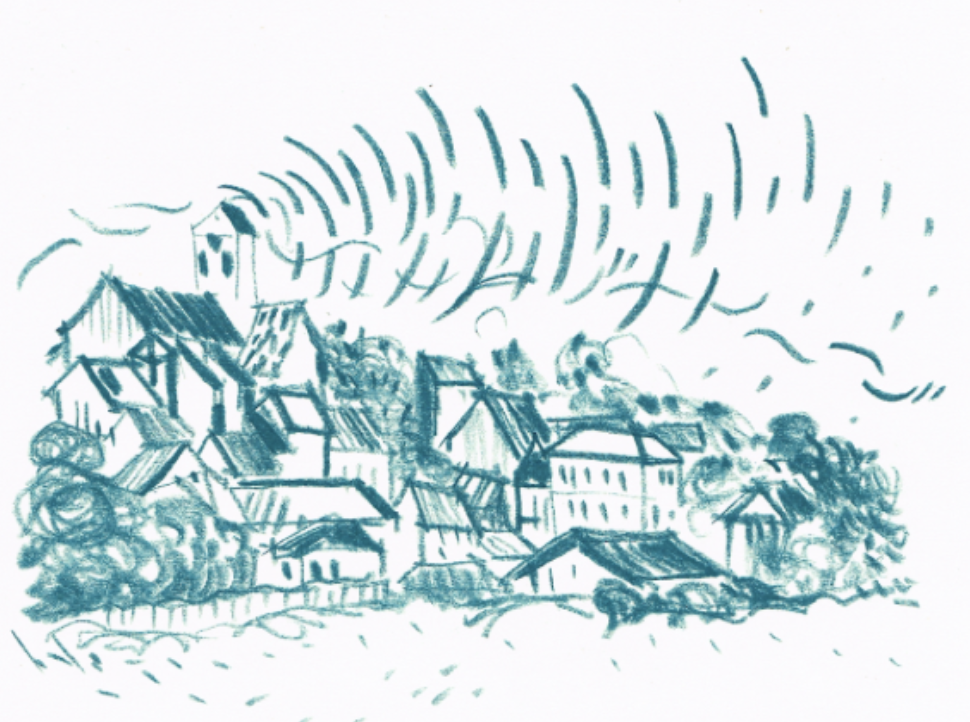Folly
Book One
4. Aural Architecture
![]()
In accompaniment to this short read, please listen to this playlist: Fogcast episode 4 by Robin The Fog on Resonance.FM
“There is nothing like silence to suggest a sense of unlimited space. Sounds lend colour to space, and confer a sort of sound body upon it. But absence of sound leaves it quite pure and, in the silence, we are seized with the sensation of something vast and deep and boundless.”
In Malicroix, Henri de Bosco describes the experience of a young man entering a period of seclusion – akin to a quarantine – and draws the portrait of a home almost exclusively through its main character’s auditory spatial awareness. Those of us forced to retreat into the corners of our homes today are given the chance to listen the same way.
The way sounds fill and inhabit space as much as we do is still overlooked. But when our clamoring worlds come to a halt, we can all become deep listeners. With the usual auditory overload gone, a neighbour walking up and down the stairs turns into an event. It materialises architecture and the location of stairs, low ceilings, walls and doors letting in and out. Architecture is audible, we also experience it by listening.
“Aural architecture, with its own beauty, aesthetics, and symbolism, parallels visual architecture.”
When we become aware of space possessing aural architecture or character, we often recall grandiose spaces such as churches and cathedrals. They are highly expressive spaces which provide enveloping listening experiences on the inside while acting as sonic landmarks – soundmarks – on the outside.
Size and boundaries of French villages used to be manifested by how far the church bells could be heard. The bells were used as early systems of communications and for calling the community together. Aural architecture influences social cohesion.
We experience something similar every Thursday in the U.K., every evening in France, when neighborhoods break into a chorus of vocalisations, hurrahs and applauds, manifesting a sense of solidarity and community despite socially distancing.
Aural architecture is a shared experience, it isn’t exclusive to architects, acoustic engineers and sound artists. Extending this even further, aural architecture includes creating spatial experiences without constructing buildings.
This is precisely what Musicity does. Exploring local soundscapes, shared collaborations result in the layering of a virtual city of aural architecture evolved from the physical one. While it is safer to stay home, I invite you to experience our virtual London:
Enter a cathedral of light with Tania Nwachukwu and Bump Kin
Crawl under the surface of Smithfield Market with Tom Richards
Fly through a busy tunnel of The Barbican with Robin The Fog
Walk around an open meadow in the City with James Alec Hardy
Solen Fluzin
“There is nothing like silence to suggest a sense of unlimited space. Sounds lend colour to space, and confer a sort of sound body upon it. But absence of sound leaves it quite pure and, in the silence, we are seized with the sensation of something vast and deep and boundless.”
In Malicroix, Henri de Bosco describes the experience of a young man entering a period of seclusion – akin to a quarantine – and draws the portrait of a home almost exclusively through its main character’s auditory spatial awareness. Those of us forced to retreat into the corners of our homes today are given the chance to listen the same way.
The way sounds fill and inhabit space as much as we do is still overlooked. But when our clamoring worlds come to a halt, we can all become deep listeners. With the usual auditory overload gone, a neighbour walking up and down the stairs turns into an event. It materialises architecture and the location of stairs, low ceilings, walls and doors letting in and out. Architecture is audible, we also experience it by listening.
“Aural architecture, with its own beauty, aesthetics, and symbolism, parallels visual architecture.”
When we become aware of space possessing aural architecture or character, we often recall grandiose spaces such as churches and cathedrals. They are highly expressive spaces which provide enveloping listening experiences on the inside while acting as sonic landmarks – soundmarks – on the outside.
Size and boundaries of French villages used to be manifested by how far the church bells could be heard. The bells were used as early systems of communications and for calling the community together. Aural architecture influences social cohesion.
We experience something similar every Thursday in the U.K., every evening in France, when neighborhoods break into a chorus of vocalisations, hurrahs and applauds, manifesting a sense of solidarity and community despite socially distancing.
Aural architecture is a shared experience, it isn’t exclusive to architects, acoustic engineers and sound artists. Extending this even further, aural architecture includes creating spatial experiences without constructing buildings.
This is precisely what Musicity does. Exploring local soundscapes, shared collaborations result in the layering of a virtual city of aural architecture evolved from the physical one. While it is safer to stay home, I invite you to experience our virtual London:
Enter a cathedral of light with Tania Nwachukwu and Bump Kin
Crawl under the surface of Smithfield Market with Tom Richards
Fly through a busy tunnel of The Barbican with Robin The Fog
Walk around an open meadow in the City with James Alec Hardy
Solen Fluzin
